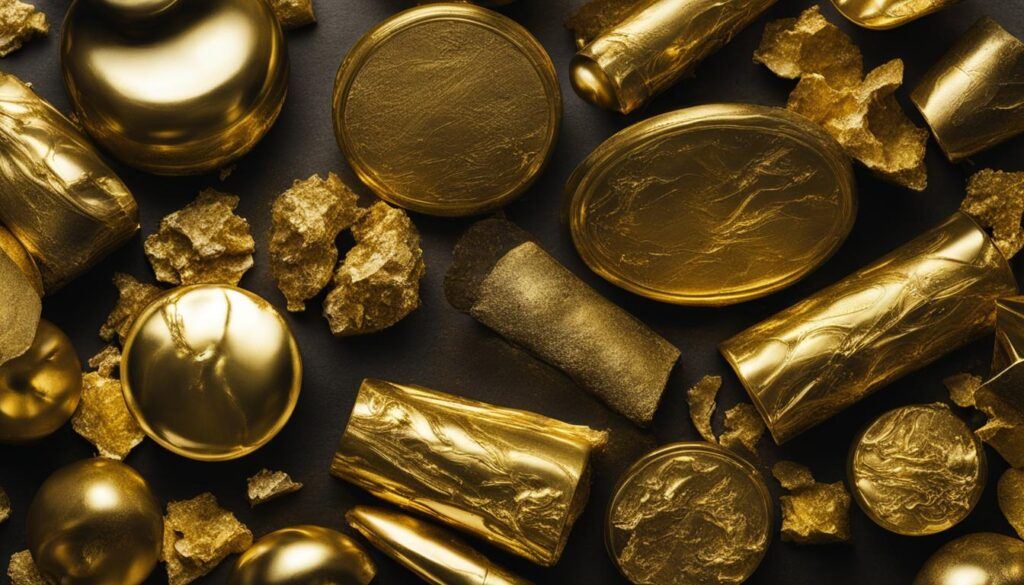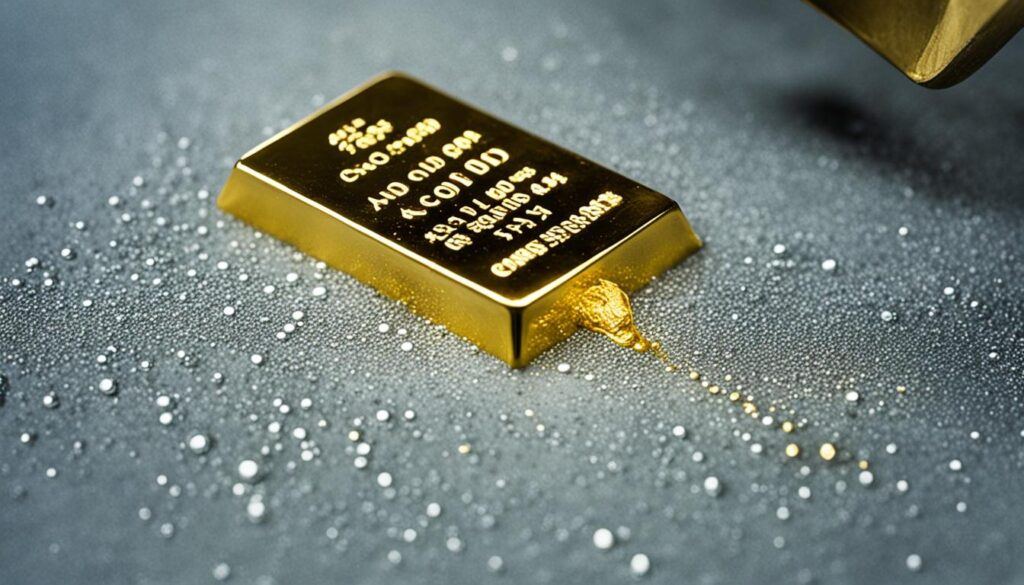Counterfeit gold is a common problem in the market, and many people wonder if fake gold can have hallmarks that mimic those found on authentic gold items. In order to understand whether fake gold can have hallmarks, it is important to know how to identify real gold and the purpose of hallmarks on genuine gold jewelry. Let’s explore the topic and find out more.
Key Takeaways:
- Fake gold can have hallmarks that mimic those found on genuine gold items.
- Hallmarks indicate the purity of gold and can help in identifying counterfeit gold.
- Several tests, such as the touch test and scratch test, can be conducted to determine the authenticity of gold.
- It is important to buy gold from reputable sellers and seek professional appraisals for accurate evaluation.
- Educating yourself about gold and its characteristics is essential for making informed investment decisions.
Understanding Gold Purity and Hallmarks
To determine the purity of gold, it is measured in karats. The higher the karat, the purer the gold. The purity of gold is often indicated by hallmarks, which are stamped on the piece of jewelry. These hallmarks specify the karat value and may also include the manufacturer’s name and the date of manufacture. It is important to understand the different karat values and their corresponding purity percentages.
In order to identify fake gold hallmarks, a variety of tests can be conducted. Let’s explore some of the most commonly used tests:
The Eye Test: This simple test involves observing the color and luster of the gold. Real gold maintains a deep, rich color and a distinct shine.
The Hallmark Analysis: Carefully examining the hallmarks on a piece of gold jewelry can reveal red flags that indicate counterfeit gold. Look for odd purity numbers that do not align with standard karat values, as well as markings like “GP” (Gold Plated), “GE” (Gold Electroplated), or “GF” (Gold Filled), which signify that the item is not genuine gold.
The Touch Test: By rubbing the gold against your skin, you can check for any discoloration or reaction. Authentic gold does not cause any discoloration or irritation on the skin.
The Scratch Test: Rubbing the gold on a piece of unglazed ceramic will leave behind a distinctive colored mark. Genuine gold leaves a gold-colored streak.
The Weight Test: Comparing the weight of the gold in question to a known piece of gold of the same purity can help determine its authenticity. Genuine gold is denser and therefore heavier than other metals.
The Magnetic Test: Real gold is not magnetic, so if the gold is attracted to a magnet, it is likely fake.
The Water Test: Placing the gold in water can reveal its density. Genuine gold is denser than other metals and will sink in water.
The Chemical Test: Vinegar or nitric acid can be used to test the authenticity of gold, although this should be done cautiously as these are potentially harmful substances. Genuine gold will not react to these chemicals.
By conducting these tests, individuals can identify fake gold and validate the authenticity of hallmarks. However, it is worth noting that for a more accurate assessment, professional tests such as the Sigma Metalytics Precious Metal Verifier or XRF Spectrometer should be considered.
Utilizing these testing methods and understanding gold purity and hallmarks is essential for making informed decisions and protecting oneself from counterfeit gold.
Common Types of Fake Gold
When it comes to fake gold, there are several common types that can be found in the market. It is important to be aware of these types in order to avoid purchasing counterfeit items. Let’s take a closer look at each type:
Gold-plated
Gold-plated items are made of a base metal, such as copper or brass, and are coated with a thin layer of gold. The layer of gold is relatively thin and may wear off over time, revealing the base metal underneath. These items are often less expensive than genuine gold, making them an attractive option for some buyers. However, it is essential to understand that gold-plated items are not solid gold and do not hold the same value.
Gold-filled
Gold-filled items have a thicker layer of gold compared to gold-plated items, but they still contain a base metal core. The gold layer is bonded to the base metal through a mechanical process, ensuring greater durability and longevity. Gold-filled items are more valuable than gold-plated ones and can maintain their appearance for a longer period of time.
Copper or Brass
Copper or brass can be manipulated and treated to resemble gold through various processes. These items may have a gold-like appearance, but they are not made of genuine gold. It is essential to closely examine and test these items to determine their authenticity.
Pyrite
Pyrite, also known as “fool’s gold,” is a mineral that exhibits a similar appearance to real gold. Its brassy yellow color can easily deceive buyers into thinking they are purchasing genuine gold. However, pyrite is not actual gold and does not hold any intrinsic value. It is important to be cautious and differentiate between pyrite and true gold when making a purchase.
By being aware of these common types of fake gold, you can make informed decisions and avoid falling victim to counterfeit items. Now that we have explored the various types of fake gold, let’s dive into the importance of hallmark analysis in the next section.

The Importance of Hallmark Analysis
Hallmark analysis is a vital aspect of distinguishing between authentic and fake gold. By carefully examining the hallmarks on gold jewelry, it is possible to identify red flags that indicate the item may be counterfeit. These red flags include odd purity numbers that do not align with standard karat values and the presence of markings such as “GP” (Gold Plated), “GE” (Gold Electroplated), or “GF” (Gold Filled), which indicate that the item is not genuine gold.
When analyzing hallmarks, it is crucial to note that older gold jewelry may not have a hallmark, but this does not necessarily mean it is fake. It is essential to exercise caution and not solely rely on the presence or absence of a hallmark to determine authenticity. The hallmark analysis should be done in conjunction with other tests and evaluations to make an informed judgment.
“Hallmark analysis allows us to uncover tell-tale signs of counterfeit gold. Identifying suspicious hallmarks is a valuable skill when it comes to protecting yourself from fraudulent purchases.” – Gold Expert
Red Flags in Hallmarks
When conducting hallmark analysis, watch out for the following red flags:
- Odd purity numbers that do not align with standard karat values
- Markings such as “GP” (Gold Plated), “GE” (Gold Electroplated), or “GF” (Gold Filled)
These indicators suggest that the gold jewelry might not be genuine. By being aware of these red flags, you can make more informed decisions when purchasing gold and minimize the risk of falling victim to counterfeit items.
Conducting Purity Tests on Gold
When trying to determine the purity of gold, several tests can be conducted. These tests vary from simple methods that can be done at home to more advanced techniques that require professional equipment or expertise. Here are some commonly used gold purity tests:
- Eye Test: This test involves visually examining the color and luster of the gold. Authentic gold generally has a distinct yellow or golden hue, while fake gold may appear dull or have a different shade.
- Touch Test: By wearing or rubbing the gold against the skin, one can check if it causes any discoloration or reaction. Genuine gold does not typically react with the skin.
- Scratch Test: To perform this test, carefully rub the gold against an unglazed ceramic surface. Real gold will leave a gold streak, while fake gold may leave a different color mark.
- Weight Test: This test compares the weight of the gold in question to a known piece of gold of the same purity. Real gold has a specific weight based on its purity.
- Magnetic Test: Authentic gold is not magnetic, so using a magnet to check if the gold is attracted to it can help identify fake gold.
- Water Test: Placing the gold in water can determine its density. Real gold is denser than most other metals and will sink, while fake gold tends to float.
- Chemical Test: Certain substances like vinegar or nitric acid can be used to test the authenticity of gold. However, chemical tests should be done with caution and preferably by professionals.
- Professional Tests: Specialized equipment like the Sigma Metalytics Precious Metal Verifier or XRF Spectrometer can provide accurate results but require the expertise of a jeweler or a professional gold-testing facility.
By conducting these gold purity tests, individuals can gain a better understanding of the authenticity and quality of their gold. However, it is important to note that while some tests can provide initial insights, obtaining a professional evaluation is recommended for more precise results.

Factors to Consider in Hallmark Authentication
When it comes to evaluating hallmarks on gold jewelry, there are several important factors to consider. These factors can help you determine the authenticity of the item and protect yourself from purchasing fake gold. Let’s explore these factors in detail:
1. Age of the Gold Jewelry
The age of the gold jewelry can play a role in the presence or absence of a hallmark. Older pieces of jewelry may not have been required to have a hallmark, so their absence doesn’t necessarily indicate that the item is fake. It is essential to consider the historical context and manufacturing practices of the time period when evaluating the presence or absence of a hallmark.
2. Faking Hallmarks
Counterfeiters can replicate hallmarks to make fake gold appear authentic. They may use various techniques to mimic genuine hallmarks, including stamping, engraving, or plating. Familiarize yourself with the specific markings and symbols used for authenticity to detect any red flags that may indicate a fake hallmark. Mistakes in fonts, spacing, or misspellings are often telltale signs of counterfeit hallmarks.
3. Professional Evaluation
If you have any doubts about the validity of a hallmark or the authenticity of your gold jewelry, it is advisable to seek a professional evaluation from a certified jeweler. A professional evaluation can provide you with accurate authentication and peace of mind. Certified jewelers have the expertise and knowledge to examine hallmarks, conduct necessary tests, and determine the purity of the gold.
Limitations of Home Testing Methods
While home testing methods can provide some insight into the authenticity of gold, it is important to recognize their limitations. Home tests can be helpful in identifying potential fake gold, but they are not 100% conclusive. Factors such as user error, the presence of other metals or substances that may interfere with the test, and the quality of testing materials can all impact the reliability of home tests.
If a higher level of certainty is required, it is recommended to have a professional test conducted by a certified jeweler or to invest in specialized equipment for accurate results. Professional testing methods provide more reliable and accurate assessments, ensuring the authenticity of gold jewelry.

Challenges with Home Testing Methods
- User error: Conducting home tests requires precision and proper understanding of testing procedures. Mistakes in executing the test can lead to inaccurate results.
- Interference from other metals or substances: The presence of metals or materials that may react with the testing agent can affect the outcome of the test and make it difficult to determine the purity of the gold.
- Quality of testing materials: The effectiveness and reliability of home testing kits can vary depending on the quality of the materials used. Inexpensive or low-quality testing kits may yield less accurate results.
“While home testing methods can provide an initial assessment, they should not be solely relied upon for definitive results. Professional testing conducted by certified jewelers ensures a higher level of accuracy and reliability.”
Therefore, to ensure the most accurate assessment of gold authenticity, it is advisable to consult a professional who has the expertise and specialized equipment to conduct thorough testing. By seeking professional testing services, individuals can have greater confidence in the authenticity and value of their gold jewelry.
Signs of Authentic Gold and Value Preservation
When it comes to gold jewelry, it is essential to be able to distinguish genuine gold from fake replicas. Authentic gold possesses certain characteristics that set it apart and ensure its long-term value. Here are some signs to look for when determining the authenticity of gold:
- Color and Lustre: Real gold maintains its natural color and lustre over time, regardless of its age. It retains its rich golden hue without fading or discoloration.
- Hallmarks: Genuine gold jewelry often bears hallmarks that indicate its purity and authenticity. Hallmarks are certified stamps that verify the gold’s quality and can provide assurance of its genuineness.
- Weight: Gold is a dense metal, and genuine gold jewelry will feel relatively heavier compared to counterfeit gold items made from lighter materials.
- Magnetism: Real gold is not magnetic. If a piece of gold jewelry is attracted to a magnet, it is likely a fake made from a different metal.
- Professional Appraisal: Having your gold jewelry professionally appraised by a certified jeweler is the best way to ensure its authenticity. A skilled appraiser will thoroughly examine the piece, conduct necessary tests, and provide an accurate assessment of its value.
Investing in authentic gold jewelry not only gives you a valuable and timeless adornment but also ensures the preservation of its worth over time. Genuine gold jewelry holds its value and can be a wise investment choice.
When it comes to preserving the value of your gold jewelry, proper care is crucial. Here are some tips to help maintain the integrity and shine of your gold pieces:
- Storage: Keep your gold jewelry stored separately in a soft pouch or a lined jewelry box to prevent scratching or damage.
- Cleaning: Regularly clean your gold jewelry using a mild soap and warm water solution. Avoid using harsh chemicals or abrasive materials that can cause scratches.
- Avoid Contact: Keep your gold jewelry away from household chemicals and any substances that can tarnish or discolor it. Remove your gold jewelry before using cleaning products, swimming, or engaging in physical activities.
- Professional Cleaning: Periodically, take your gold jewelry to a professional jeweler for a thorough cleaning and inspection. They can help remove any built-up dirt or grime and check for any potential issues.
By paying attention to these signs of authentic gold and taking proper care of your gold jewelry, you can ensure its long-term value and enjoy its beauty for years to come.
Importance of Buying from Reputable Sellers
When it comes to purchasing gold, one of the most crucial factors in ensuring authenticity and avoiding counterfeit gold is buying from reputable sellers. Reputable gold sellers prioritize customer trust and satisfaction by offering genuine gold that is accurately represented. They have a track record of providing authentic gold products, often backed by certifications or guarantees to verify the purity and authenticity of their offerings.
By conducting thorough research and purchasing from trusted sources, individuals can significantly reduce the risk of falling victim to counterfeit gold. Reputable sellers invest in maintaining their reputation by sourcing gold from reliable suppliers and adhering to strict quality standards. This commitment to authenticity gives buyers peace of mind, knowing they are acquiring genuine gold that holds its value and integrity.
Moreover, reputable sellers understand the importance of transparency and provide detailed information about their gold products. They are knowledgeable about gold purity, hallmarks, and the various authentication methods. This expertise enables them to answer any questions or concerns that potential buyers may have, ensuring a seamless and trustworthy buying experience.
Benefits of Buying from Reputable Sellers:
- Reliable source of genuine gold
- Accurate representation of gold products
- High-quality standards and certifications
- Transparent and knowledgeable customer service
- Assurance of value and authenticity
“Buying gold from reputable sellers provides the assurance that you are investing in genuine gold and protecting yourself from counterfeit products.” – Gold Expert
Remember, reputable gold sellers prioritize customer satisfaction and are committed to delivering authentic gold that meets the highest standards. By purchasing from trusted sources, individuals can confidently invest in gold and avoid the risks associated with counterfeit gold.
| Benefits of Buying from Reputable Sellers |
|---|
| Reliable source of genuine gold |
| Accurate representation of gold products |
| High-quality standards and certifications |
| Transparent and knowledgeable customer service |
| Assurance of value and authenticity |
Image:
Educating Yourself for Gold Investment
As someone interested in gold investment, it is essential to educate yourself about the precious metal and its characteristics. Knowledge is power in the world of gold investing, and being well-informed will enable you to make informed decisions and protect yourself from counterfeit gold.
One of the key aspects to understand is the various tests and authentication methods used to determine the authenticity of gold. By familiarizing yourself with these tests, such as the eye test, touch test, scratch test, weight test, magnetic test, water test, and chemical test, you can confidently assess the genuineness of gold items you come across.
Furthermore, grasping the significance of hallmarks is crucial. Hallmarks not only denote the purity of gold but also provide valuable information about the manufacturer and date of manufacture. Understanding the symbols and numbers associated with hallmarks will help you spot any inconsistencies or red flags that may indicate a piece of gold is fake.
Staying informed about the latest developments and trends in the gold market is another vital aspect of educating yourself. By keeping up with market news, industry insights, and expert opinions, you can gain valuable insights that can influence your investing decisions.
To enhance your understanding of gold investing, consider reading books, articles, and research papers written by renowned experts in the field. Attend conferences, seminars, and webinars conducted by industry professionals to stay up-to-date with the evolving dynamics of the gold market.
Remember, knowledge is power when it comes to gold investing. The more you educate yourself, the better equipped you will be to make sound investment decisions and navigate the gold market with confidence.

The Benefits of Education in Gold Investing
Here are some key reasons why educating yourself for gold investment is essential:
- Identify counterfeit gold and avoid financial losses
- Make informed decisions based on market trends and insights
- Protect your investments and ensure their value preservation
- Gain confidence and peace of mind in your investment choices
- Spot investment opportunities and capitalize on them
Educating yourself about gold investing is an ongoing process. Continuously expand your knowledge, stay curious, and seek out reputable sources to enhance your understanding. By doing so, you will become a well-informed investor and increase your chances of success in the thrilling world of gold investment.
Importance of Professional Appraisal
While home testing methods can provide a general idea about the authenticity of gold, a professional appraisal conducted by a certified jeweler offers the highest level of accuracy and certainty. Professional Gold Appraisal ensures that you receive a reliable assessment of your gold’s authenticity and value, whether you seek personal assurance or plan to sell your precious jewelry.
Professional appraisers possess the expertise, specialized tools, and extensive knowledge necessary to accurately evaluate gold jewelry and determine its purity. With their professional training and experience, they can provide a thorough examination, taking into account various factors such as the karat value, craftsmanship, and overall condition of the piece.
I always recommend seeking a certified jeweler evaluation for gold appraisal. Their comprehensive understanding of gold characteristics and industry standards enables them to deliver precise judgments that go beyond what a home test can provide.
Moreover, a professional appraisal carries credibility and helps establish the accurate market value of your gold. This can be beneficial when dealing with potential buyers or insurance claims, as it ensures a fair transaction and protects your valuable investment.
Remember, a professional gold appraisal not only serves to authenticate your gold but also provides you with invaluable insights into its quality and worth. It is an essential step in safeguarding your assets and making informed decisions regarding your gold jewelry.
| Benefits of Professional Appraisal | Why Choose a Certified Jeweler |
|---|---|
|
|
Conclusion
In conclusion, understanding the significance of hallmarks and conducting thorough tests for gold purity are crucial in the identification of authentic gold. The presence of hallmarks on gold jewelry serves as an important indicator of its authenticity, providing valuable information about the karat value and manufacturer. By familiarizing themselves with these hallmarks and conducting tests such as the eye test, touch test, scratch test, weight test, magnetic test, water test, and chemical test, individuals can confidently differentiate real gold from counterfeit items.
Seeking professional evaluations from certified jewelers further enhances the accuracy of gold authentication. Professional appraisers have the expertise and specialized tools necessary to provide reliable assessments of a gold piece’s authenticity and value. While home testing methods can provide initial insights, a professional appraisal offers the highest level of certainty.
Investing in genuine gold not only ensures the preservation of its value but also provides a trustworthy and lasting asset. By educating themselves about gold and its characteristics, individuals can make informed investment decisions and protect themselves from purchasing counterfeit gold. It is crucial to buy from reputable sellers who offer certifications or guarantees to verify the purity and authenticity of the gold.
In conclusion, distinguishing real gold from fakes requires a combination of knowledge, examination of hallmarks, and conducting tests for gold purity. By exercising caution and seeking professional evaluations, individuals can confidently invest in authentic gold and avoid the pitfalls of counterfeit items.
FAQ
Does fake gold have hallmarks?
Yes, fake gold can have hallmarks that mimic those found on authentic gold items. However, there are ways to identify fake gold hallmarks and differentiate them from genuine ones.
What are hallmarks and how do they relate to gold purity?
Hallmarks are stamped markings on gold jewelry that indicate the purity of the gold. They specify the karat value and may include other information like the manufacturer’s name and the date of manufacture.
What are the different types of fake gold?
Common types of fake gold include gold-plated items, which have a thin layer of gold over a base metal, and gold-filled items, which have a thicker layer of gold but still contain a base metal core. Copper or brass can also be manipulated to look like gold, and pyrite is often mistaken for gold due to its similar appearance.
How can hallmark analysis help identify fake gold?
By carefully examining the hallmarks on gold jewelry, red flags can be identified that indicate the item may be counterfeit. Odd purity numbers and markings like “GP,” “GE,” or “GF” are signs of fake gold.
What tests can be conducted to determine gold purity?
There are various tests, including the eye test, touch test, scratch test, weight test, magnetic test, water test, and chemical test, that can help determine the authenticity of gold.
What factors should be considered in hallmark authentication?
The age of the gold jewelry can impact the presence or absence of a hallmark. Counterfeiters can also replicate hallmarks, so it’s important to be knowledgeable about specific markings and symbols used for authenticity.
What are the limitations of home testing methods for gold?
Home tests can provide a general idea about gold authenticity but are not 100% conclusive. Factors such as user error, the presence of other metals or substances, and the quality of testing materials can impact the reliability of home tests.
What are the signs of authentic gold and how can its value be preserved?
Authentic gold maintains its color and lustre over time and holds its value as a valuable investment. Proper care of gold jewelry is essential for preserving its value and integrity.
Why is it important to buy from reputable sellers?
Reputable sellers ensure that their gold is genuine and accurately represented. They have a track record of providing authentic products and may offer certifications or guarantees for purity and authenticity verification.
Why is educating oneself about gold important for investment purposes?
By understanding gold characteristics, tests, and authentication methods, individuals can make informed decisions and protect themselves from counterfeit gold. Knowledge empowers individuals to navigate the gold market confidently.
What is the importance of professional appraisal for gold?
Professional appraisals conducted by certified jewelers offer the highest level of accuracy and certainty. Appraisers have the expertise, specialized tools, and knowledge to accurately evaluate gold jewelry and determine its purity.



